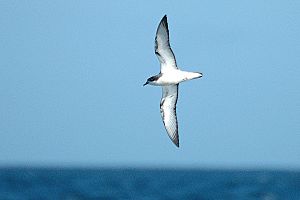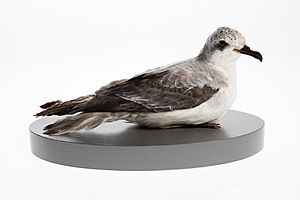Cook's petrel facts for kids
Quick facts for kids Cook's petrel |
|
|---|---|
 |
|
| Conservation status | |
| Scientific classification | |
| Genus: |
Pterodroma
|
| Species: |
cookii
|
The Cook's petrel (Pterodroma cookii), also called the blue-footed petrel, is a type of seabird. It belongs to a group of birds called gadfly petrels. These birds are known for their fast, darting flight over the ocean. The Cook's petrel is very similar to another bird, Stejneger's petrel.
Contents
What Does a Cook's Petrel Look Like?

The Cook's petrel is one of the smallest petrels. It is about 25 to 30 centimeters (10 to 12 inches) long. Its wings can spread out to about 65 to 66 centimeters (25 to 26 inches). This bird weighs around 200 grams (7 ounces), which is about the same as a small can of soda.
Its colors are typical for a gadfly petrel. It has light grey feathers on its back and wings. You might see a dark grey "M" shape on its wings when it flies. Its belly and chest are white.
The Cook's petrel has a long, black beak. Its nostrils are like small tubes on both sides of its beak. This special nose helps the bird smell really well. They use their amazing sense of smell to find food and their nests, even in the dark!
What Do Cook's Petrels Eat?
Cook's petrels mainly eat fish and squid. They also sometimes eat small crustaceans, which are like tiny ocean bugs. These birds spend almost all their time far out in the open ocean. This is called being "pelagic." They only come to land when it's time to build their nests and raise their young.
Where Do Cook's Petrels Live?
Cook's petrels only make their nests in New Zealand. They choose three small islands for breeding: Little Barrier Island, Great Barrier Island, and Codfish Island. They breed during the southern summer, from October to May.
These birds build their nests in burrows (tunnels in the ground) or in cracks in rocks. They like to nest on thick, forested ridges. Long ago, there were many more Cook's petrels. Today, there are about 1,258,000 of them, but their numbers are going down.
They are considered a vulnerable species because they only nest on these three small islands. The population on Little Barrier Island is staying steady. However, the birds on Great Barrier Island and Codfish Island are decreasing. On Great Barrier Island, animals like pigs, dogs, rats, and cats can disturb their nests. Native weka birds also prey on their eggs and chicks. This has caused the population on Great Barrier Island to drop from about 20,000 to only 100 birds.
When it's not breeding season, Cook's petrels fly across the Pacific Ocean from New Zealand. They have been seen off the west coast of the United States and near the tropical west coast of South America.
See also
 In Spanish: Petrel de Cook para niños
In Spanish: Petrel de Cook para niños



